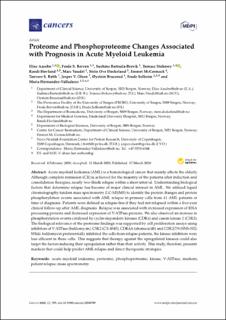| dc.contributor.author | Aasebø, Elise | |
| dc.contributor.author | Berven, Frode | |
| dc.contributor.author | Bartaula-Brevik, Sushma | |
| dc.contributor.author | Stokowy, Tomasz | |
| dc.contributor.author | Hovland, Randi | |
| dc.contributor.author | Vaudel, Marc | |
| dc.contributor.author | Døskeland, Stein Ove | |
| dc.contributor.author | Mc Cormack, Emmet | |
| dc.contributor.author | Batth, Tanveer S | |
| dc.contributor.author | Olsen, Jesper V | |
| dc.contributor.author | Bruserud, Øystein | |
| dc.contributor.author | Selheim, Frode | |
| dc.contributor.author | Hernandez-Valladares, Maria | |
| dc.date.accessioned | 2021-03-05T11:46:02Z | |
| dc.date.available | 2021-03-05T11:46:02Z | |
| dc.date.created | 2020-04-29T11:25:45Z | |
| dc.date.issued | 2020 | |
| dc.Published | Cancers. 2020, 12 (3), 709-709. | |
| dc.identifier.issn | 2072-6694 | |
| dc.identifier.uri | https://hdl.handle.net/11250/2731839 | |
| dc.description.abstract | Acute myeloid leukemia (AML) is a hematological cancer that mainly affects the elderly. Although complete remission (CR) is achieved for the majority of the patients after induction and consolidation therapies, nearly two-thirds relapse within a short interval. Understanding biological factors that determine relapse has become of major clinical interest in AML. We utilized liquid chromatography tandem mass spectrometry (LC-MS/MS) to identify the protein changes and protein phosphorylation events associated with AML relapse in primary cells from 41 AML patients at time of diagnosis. Patients were defined as relapse-free if they had not relapsed within a five-year clinical follow-up after AML diagnosis. Relapse was associated with increased expression of RNA processing proteins and decreased expression of V-ATPase proteins. We also observed an increase in phosphorylation events catalyzed by cyclin-dependent kinases (CDKs) and casein kinase 2 (CSK2). The biological relevance of the proteome findings was supported by cell proliferation assays using inhibitors of V-ATPase (bafilomycin), CSK2 (CX-4945), CDK4/6 (abemaciclib) and CDK2/7/9 (SNS-032). While bafilomycin preferentially inhibited the cells from relapse patients, the kinase inhibitors were less efficient in these cells. This suggests that therapy against the upregulated kinases could also target the factors inducing their upregulation rather than their activity. This study, therefore, presents markers that could help predict AML relapse and direct therapeutic strategies. | en_US |
| dc.language.iso | eng | en_US |
| dc.publisher | MDPI | en_US |
| dc.rights | Navngivelse 4.0 Internasjonal | * |
| dc.rights.uri | http://creativecommons.org/licenses/by/4.0/deed.no | * |
| dc.title | Proteome and Phosphoproteome Changes Associated with Prognosis in Acute Myeloid Leukemia | en_US |
| dc.type | Journal article | en_US |
| dc.type | Peer reviewed | en_US |
| dc.description.version | publishedVersion | en_US |
| dc.rights.holder | Copyright 2020 by the authors. | en_US |
| dc.source.articlenumber | 709 | en_US |
| cristin.ispublished | true | |
| cristin.fulltext | original | |
| cristin.qualitycode | 1 | |
| dc.identifier.doi | 10.3390/cancers12030709 | |
| dc.identifier.cristin | 1808595 | |
| dc.source.journal | Cancers | en_US |
| dc.source.40 | 12 | |
| dc.source.14 | 3 | |
| dc.identifier.citation | Cancers. 2020, 12 (3), 709. | en_US |
| dc.source.volume | 12 | en_US |
| dc.source.issue | 3 | en_US |

